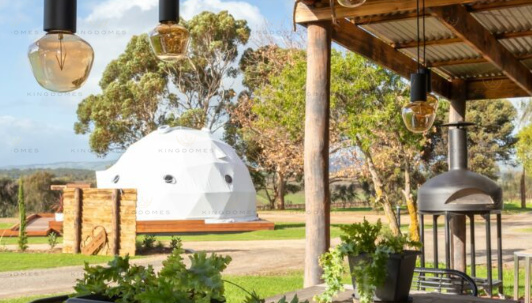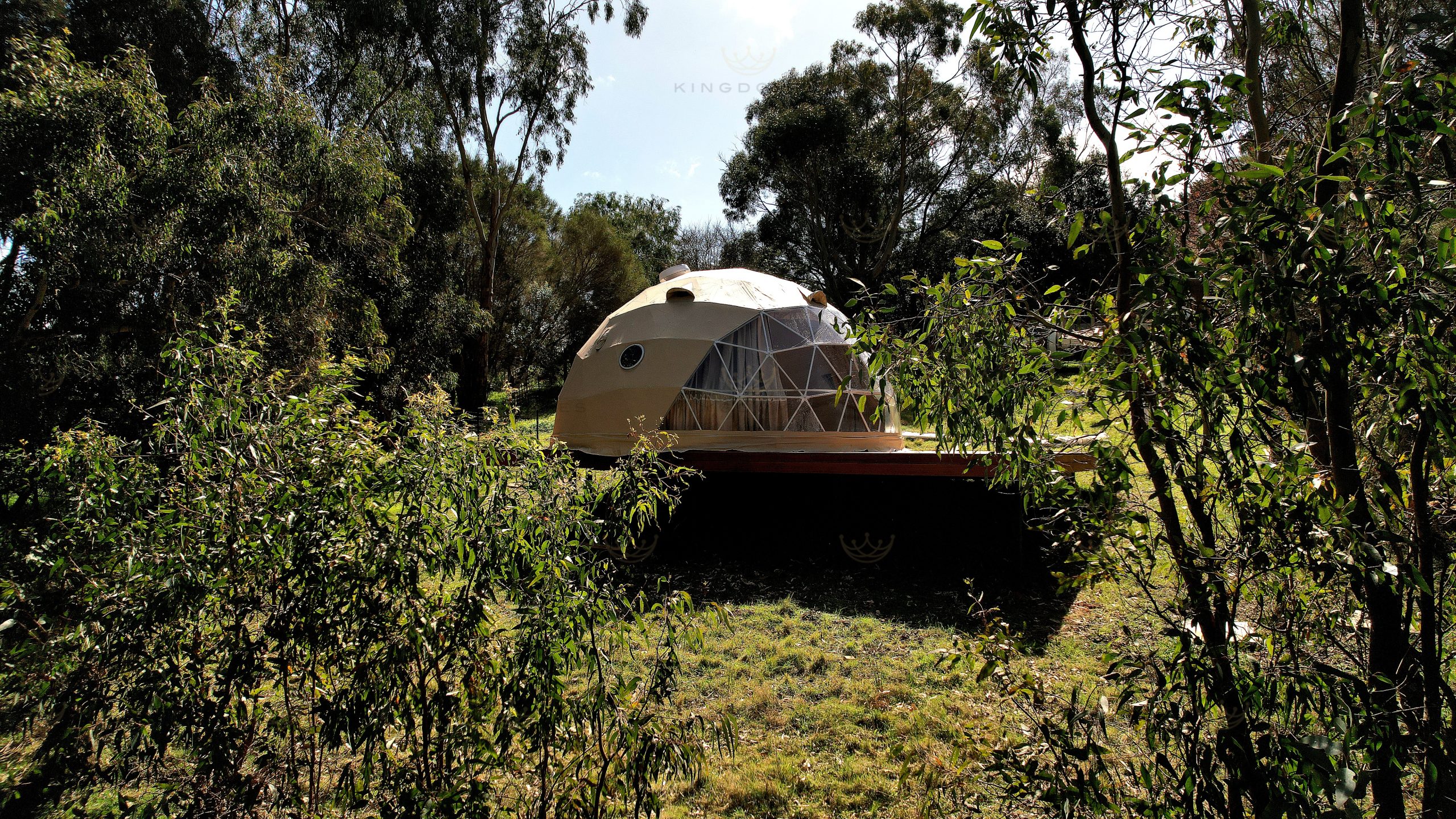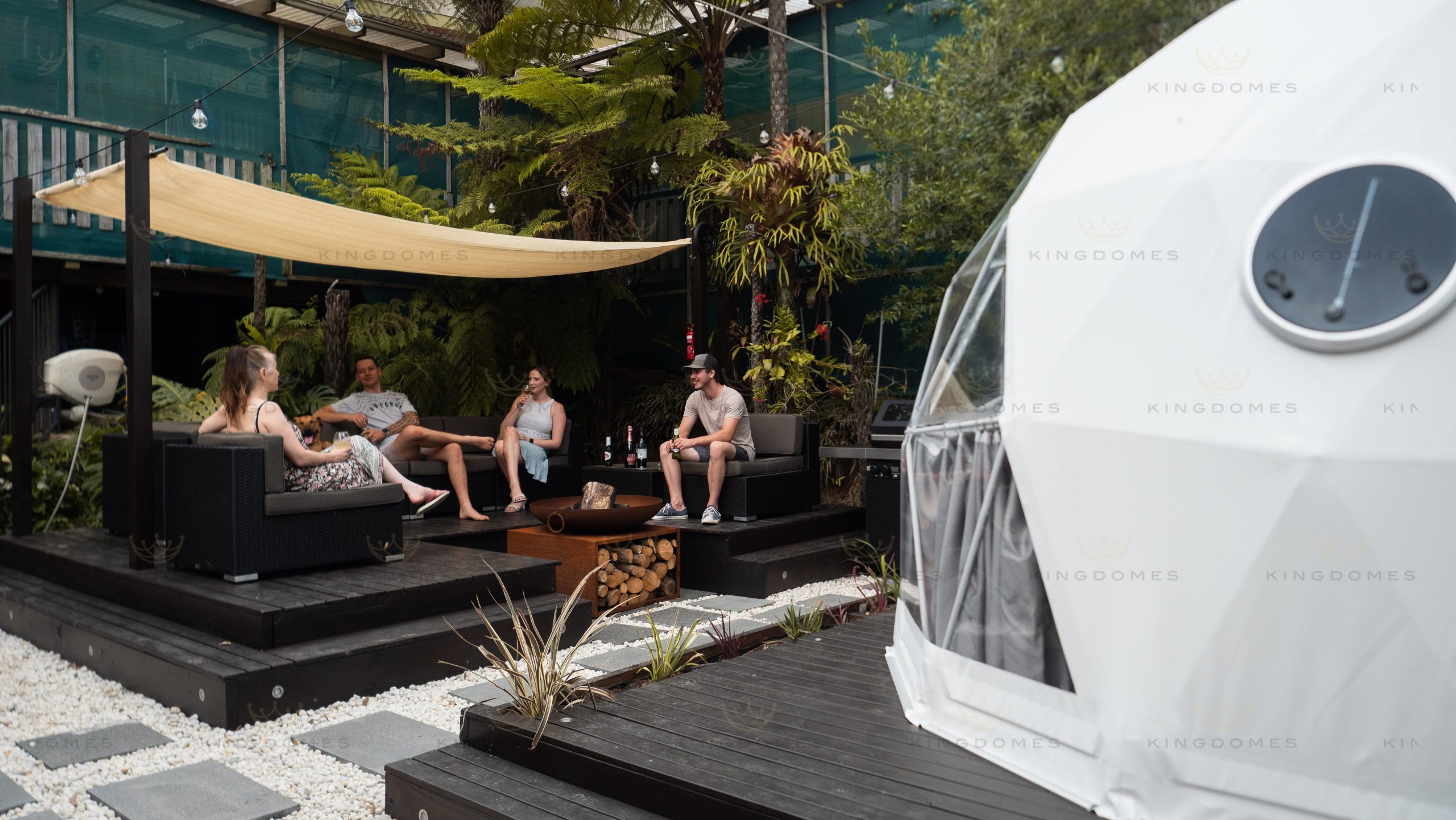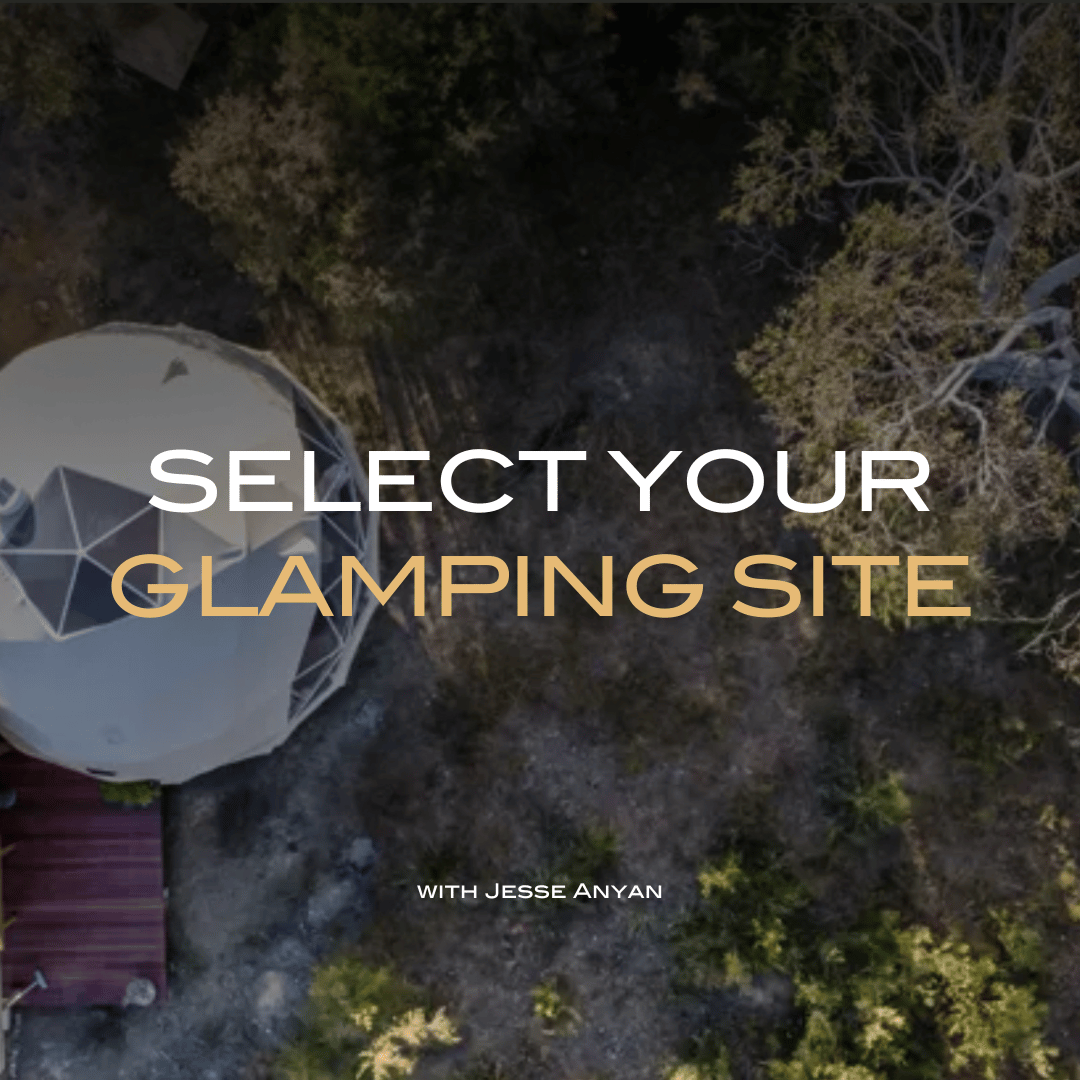Introduction
Choosing the perfect location for your King Dome is one of the most crucial steps in ensuring the success of your glamping venture. The right location can enhance your guests’ experience, provide stunning views, and ensure the longevity and stability of your dome. In this guide, we’ll walk you through the key factors to consider when selecting the ideal spot for your King Dome, from ground quality and water runoff to access and views.
Whether you are using our domes for glamping or yoga, a home dome or personal retreat, this guide will help you optimise your site for convenience, longevity, and access to your King Dome.
If you’d prefer to listen or watch instead, feel free to play the video.
Summarised Version
Continue scrolling down to read the detailed version
10 Key Factors
- Ground Quality and Land Gradient: Ensure stable soil and a suitable slope. The greater the slope, the more expensive the project. Assess soil stability, remove problematic roots, and evaluate the land gradient.
- Water Runoff and Drainage: Proper drainage prevents water pooling under the platform and eroding the area over time. Assess water flow and install drainage systems to direct water away from the dome.
- Access to the Site: Plan for easy access for construction materials and guests. Ensure space for vehicle parking and manoeuvring, and plan for maintenance access, including maintenance vehicles.
- Trees and Natural Features: Incorporate trees for shade and aesthetics, but manage risks from falling branches and bushfires. Position trees to maximize benefits and minimize hazards.
- Views and Orientation: Maximize scenic views, considering sunrise and sunset orientations for guest enjoyment. Balance views with privacy and seclusion.
- Service Locations: Position water tanks and solar panels for optimal efficiency. Ensure easy access for maintenance and refilling.
- Local Climate and Weather Patterns: Research local climate to understand how the site reacts to various weather conditions throughout the year. This also includes the access to the site from the road.
- Environmental Impact and Sustainability: Minimize environmental footprint by choosing sustainable practices and preserving the local ecosystem. Work with the local flora and fauna, rather than unnecessarily destroying it.
- Legal, Regulatory, and Safety Considerations: Understand zoning laws, obtain necessary permits, comply with local regulations, and implement safety measures. Assess natural hazards and ensure proper lighting and emergency plans. Include examples where necessary.
- Budget and Cost Considerations: Budget for land and initial setup costs. Plan for ongoing maintenance and operational costs.




Detailed Version
Ground Quality and Land Gradient
One of the first considerations when choosing a location for your King Dome is the quality of the ground and the gradient of the land. A stable foundation and a suitable slope are essential for ensuring the longevity and safety of your dome. The greater the slope, the more expensive the project becomes due to the additional engineering and construction requirements.
- Assessing Soil Stability: Check whether the ground is hard or soft. Soft ground can be susceptible to sinking, erosion, or undermining, which can compromise the stability of your dome.
- Vegetation and Root Systems: The types of vegetation and root systems present can affect the foundation. Roots can cause movement and instability over time.
- Preparation Tips: Clear any vegetation and ensure a level surface. Methods such as spraying the area and laying weed mats or geofabric can help minimize potential issues with undergrowth, insects, and animals.
- Evaluating the Slope: Assess if the land gradient is suitable for your dome. Steep gradients may require retaining walls or special drainage solutions.
- Foundation Choices: Choose between a concrete slab and a deck based on the slope. Concrete slabs are ideal for flat areas, while decks work better on slopes.
Water Runoff and Drainage
Proper drainage is crucial to prevent water from pooling around your King Dome, which can lead to erosion and other structural issues. You don’t want water to pool under the platform and erode the area over time.
- Assessing Water Flow: Determine if water runs off the site or pools around it.
- Installing Drainage Systems: Install trenches and drains to direct water away from the foundation. Ensure drainage runs downhill to avoid water accumulation.
Access to the Site
Easy access to your site is crucial for both the construction process and for guests. Proper planning can save time and reduce costs associated with transportation and logistics.
- Material and Guest Access: Ensure the site is accessible for construction materials and guests. Consider how construction vehicles and maintenance vehicles will reach the site.
- Vehicle Considerations: Accommodate different types of vehicles, from small cars to larger trucks. Ensure there is enough space for parking and manoeuvring.
- Maintenance Access: Plan for ongoing maintenance and cleaning access. Ensure that you and your staff can easily reach the dome for routine upkeep without hassle.
Trees and Natural Features
Incorporating natural features like trees into your King Dome site can add to its charm and appeal. However, there are some risks and considerations to keep in mind.
- Benefits of Trees: Trees provide shade and enhance the aesthetic appeal of your site. They can also help keep the dome cooler in summer.
- Risks to Consider: Be aware of potential dangers such as widow makers (dead branches that can fall) and bushfires. Choose tree species wisely and maintain them regularly to minimize these risks.
- Strategic Placement: Position your dome to maximize the benefits of natural features while minimizing risks. Ensure trees are far enough away to prevent damage from falling branches but close enough to provide shade and aesthetic appeal.
Views and Orientation
One of the main attractions of staying in a King Dome is the opportunity to enjoy beautiful natural views. Properly orienting your dome can significantly enhance the guest experience.
- Maximizing Scenic Views: Choose a spot with the best natural views, such as mountains, forests, or water bodies. Position your dome to take full advantage of these vistas.
- Sunrise and Sunset Considerations: Consider whether your guests would appreciate a view of the sunrise or sunset. Orient your dome to capture these moments.
Service Locations
Properly positioning service locations is essential for the functionality and convenience of your King Dome.
- Water and Power Supply: Position water tanks and solar panels for optimal efficiency. Ensure easy access for maintenance and refilling.
- Accessibility of Services: Plan the placement of service connections for electricity, water, and gas. Ensure they are easily accessible for repairs and upgrades.
Local Climate and Weather Patterns
Understanding the local climate and weather patterns is crucial for planning the construction and maintenance of your King Dome. This also includes understanding how the site reacts to various weather conditions throughout the year and the access to the site from the road.
- Understanding Local Climate: Research the local climate to understand typical weather patterns and extreme conditions.
- Impact on Dome Material and Maintenance: Choose materials and maintenance plans that can withstand local weather conditions.
- Seasonal Considerations: Plan for extreme weather conditions like heavy rainfall, snow, or high winds.
Environmental Impact and Sustainability
Minimizing the environmental impact of your King Dome site is essential for sustainability and guest appeal. It is important to not unnecessarily destroy the local flora and fauna, but instead to work with and incorporate it.
- Minimising Environmental Footprint: Choose a location that minimizes environmental impact.
- Sustainable Practices: Incorporate sustainable practices in site selection and dome setup.
- Local Flora and Fauna: Understand and preserve the local ecosystem. Work with the existing landscape to maintain the natural beauty and integrity of the area.
Legal, Regulatory, and Safety Considerations
Understanding and complying with local laws and regulations is crucial for the successful establishment of your King Dome. Ensuring the safety and security of your guests is paramount.
- Zoning Laws and Permits: Understand local zoning laws and obtain necessary permits. For example, some areas may require specific permits for glamping sites or have restrictions on land use.
- Compliance with Local Regulations: Ensure your dome complies with local building codes and environmental regulations. This includes meeting standards for fire safety, sanitation, and structural integrity.
- Insurance Requirements: Understand insurance requirements for your glamping site. This may include liability insurance, property insurance, and coverage for natural disasters.
- Natural Hazards: Assess and mitigate risks from natural hazards like floods, landslides, and fires. For instance, if your site is in a flood-prone area, consider building on higher ground or implementing flood prevention measures.
- Guest Safety: Ensure the site is safe for guests, including proper lighting and emergency plans. Have clear signage for emergency exits, provide safety instructions, and ensure first aid supplies are readily available.
- Security Measures: Implement security measures to protect guests and property. This could include surveillance cameras, secure entry points, and regular patrols.
Budget and Cost Considerations
Financial planning is crucial for the success of your King Dome project. Consider both initial and ongoing costs.
- Initial Investment: Budget for the cost of land and initial setup, including site preparation and construction.
- Ongoing Maintenance Costs: Plan for ongoing maintenance and operational costs to keep the dome in good condition.
- Cost-Benefit Analysis: Conduct a cost-benefit analysis to determine the financial feasibility of the location. Compare potential revenue with costs to ensure the site is a worthwhile investment.
Conclusion
Choosing the right location for your King Dome requires careful consideration of multiple factors, from the ground quality and drainage to access and views. By taking the time to assess these elements, you can ensure that your dome is not only beautiful and comfortable but also durable and sustainable. With the perfect location, your King Dome will provide an unforgettable experience for your guests, blending luxury with the beauty of nature.





